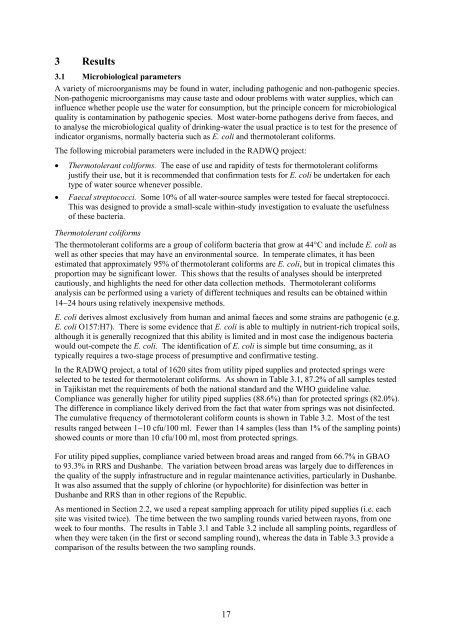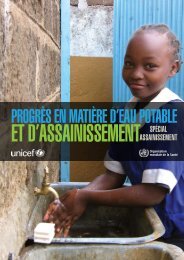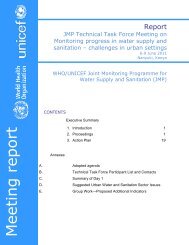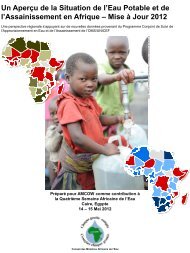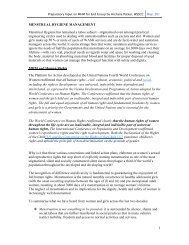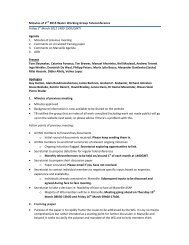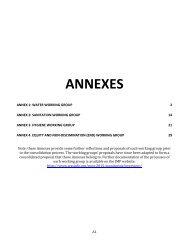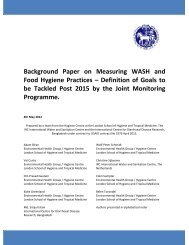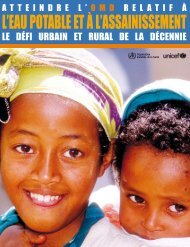rapid assessment of drinking-water quality in the republic of tajikistan
rapid assessment of drinking-water quality in the republic of tajikistan
rapid assessment of drinking-water quality in the republic of tajikistan
Create successful ePaper yourself
Turn your PDF publications into a flip-book with our unique Google optimized e-Paper software.
3 Results<br />
3.1 Microbiological parameters<br />
A variety <strong>of</strong> microorganisms may be found <strong>in</strong> <strong>water</strong>, <strong>in</strong>clud<strong>in</strong>g pathogenic and non-pathogenic species.<br />
Non-pathogenic microorganisms may cause taste and odour problems with <strong>water</strong> supplies, which can<br />
<strong>in</strong>fluence whe<strong>the</strong>r people use <strong>the</strong> <strong>water</strong> for consumption, but <strong>the</strong> pr<strong>in</strong>ciple concern for microbiological<br />
<strong>quality</strong> is contam<strong>in</strong>ation by pathogenic species. Most <strong>water</strong>-borne pathogens derive from faeces, and<br />
to analyse <strong>the</strong> microbiological <strong>quality</strong> <strong>of</strong> <strong>dr<strong>in</strong>k<strong>in</strong>g</strong>-<strong>water</strong> <strong>the</strong> usual practice is to test for <strong>the</strong> presence <strong>of</strong><br />
<strong>in</strong>dicator organisms, normally bacteria such as E. coli and <strong>the</strong>rmotolerant coliforms.<br />
The follow<strong>in</strong>g microbial parameters were <strong>in</strong>cluded <strong>in</strong> <strong>the</strong> RADWQ project:<br />
<br />
<br />
Thermotolerant coliforms. The ease <strong>of</strong> use and <strong>rapid</strong>ity <strong>of</strong> tests for <strong>the</strong>rmotolerant coliforms<br />
justify <strong>the</strong>ir use, but it is recommended that confirmation tests for E. coli be undertaken for each<br />
type <strong>of</strong> <strong>water</strong> source whenever possible.<br />
Faecal streptococci. Some 10% <strong>of</strong> all <strong>water</strong>-source samples were tested for faecal streptococci.<br />
This was designed to provide a small-scale with<strong>in</strong>-study <strong>in</strong>vestigation to evaluate <strong>the</strong> usefulness<br />
<strong>of</strong> <strong>the</strong>se bacteria.<br />
Thermotolerant coliforms<br />
The <strong>the</strong>rmotolerant coliforms are a group <strong>of</strong> coliform bacteria that grow at 44°C and <strong>in</strong>clude E. coli as<br />
well as o<strong>the</strong>r species that may have an environmental source. In temperate climates, it has been<br />
estimated that approximately 95% <strong>of</strong> <strong>the</strong>rmotolerant coliforms are E. coli, but <strong>in</strong> tropical climates this<br />
proportion may be significant lower. This shows that <strong>the</strong> results <strong>of</strong> analyses should be <strong>in</strong>terpreted<br />
cautiously, and highlights <strong>the</strong> need for o<strong>the</strong>r data collection methods. Thermotolerant coliforms<br />
analysis can be performed us<strong>in</strong>g a variety <strong>of</strong> different techniques and results can be obta<strong>in</strong>ed with<strong>in</strong><br />
1424 hours us<strong>in</strong>g relatively <strong>in</strong>expensive methods.<br />
E. coli derives almost exclusively from human and animal faeces and some stra<strong>in</strong>s are pathogenic (e.g.<br />
E. coli О157:Н7). There is some evidence that E. coli is able to multiply <strong>in</strong> nutrient-rich tropical soils,<br />
although it is generally recognized that this ability is limited and <strong>in</strong> most case <strong>the</strong> <strong>in</strong>digenous bacteria<br />
would out-compete <strong>the</strong> E. coli. The identification <strong>of</strong> E. coli is simple but time consum<strong>in</strong>g, as it<br />
typically requires a two-stage process <strong>of</strong> presumptive and confirmative test<strong>in</strong>g.<br />
In <strong>the</strong> RADWQ project, a total <strong>of</strong> 1620 sites from utility piped supplies and protected spr<strong>in</strong>gs were<br />
selected to be tested for <strong>the</strong>rmotolerant coliforms. As shown <strong>in</strong> Table 3.1, 87.2% <strong>of</strong> all samples tested<br />
<strong>in</strong> Tajikistan met <strong>the</strong> requirements <strong>of</strong> both <strong>the</strong> national standard and <strong>the</strong> WHO guidel<strong>in</strong>e value.<br />
Compliance was generally higher for utility piped supplies (88.6%) than for protected spr<strong>in</strong>gs (82.0%).<br />
The difference <strong>in</strong> compliance likely derived from <strong>the</strong> fact that <strong>water</strong> from spr<strong>in</strong>gs was not dis<strong>in</strong>fected.<br />
The cumulative frequency <strong>of</strong> <strong>the</strong>rmotolerant coliform counts is shown <strong>in</strong> Table 3.2. Most <strong>of</strong> <strong>the</strong> test<br />
results ranged between 110 cfu/100 ml. Fewer than 14 samples (less than 1% <strong>of</strong> <strong>the</strong> sampl<strong>in</strong>g po<strong>in</strong>ts)<br />
showed counts or more than 10 cfu/100 ml, most from protected spr<strong>in</strong>gs.<br />
For utility piped supplies, compliance varied between broad areas and ranged from 66.7% <strong>in</strong> GBAO<br />
to 93.3% <strong>in</strong> RRS and Dushanbe. The variation between broad areas was largely due to differences <strong>in</strong><br />
<strong>the</strong> <strong>quality</strong> <strong>of</strong> <strong>the</strong> supply <strong>in</strong>frastructure and <strong>in</strong> regular ma<strong>in</strong>tenance activities, particularly <strong>in</strong> Dushanbe.<br />
It was also assumed that <strong>the</strong> supply <strong>of</strong> chlor<strong>in</strong>e (or hypochlorite) for dis<strong>in</strong>fection was better <strong>in</strong><br />
Dushanbe and RRS than <strong>in</strong> o<strong>the</strong>r regions <strong>of</strong> <strong>the</strong> Republic.<br />
As mentioned <strong>in</strong> Section 2.2, we used a repeat sampl<strong>in</strong>g approach for utility piped supplies (i.e. each<br />
site was visited twice). The time between <strong>the</strong> two sampl<strong>in</strong>g rounds varied between rayons, from one<br />
week to four months. The results <strong>in</strong> Table 3.1 and Table 3.2 <strong>in</strong>clude all sampl<strong>in</strong>g po<strong>in</strong>ts, regardless <strong>of</strong><br />
when <strong>the</strong>y were taken (<strong>in</strong> <strong>the</strong> first or second sampl<strong>in</strong>g round), whereas <strong>the</strong> data <strong>in</strong> Table 3.3 provide a<br />
comparison <strong>of</strong> <strong>the</strong> results between <strong>the</strong> two sampl<strong>in</strong>g rounds.<br />
17


